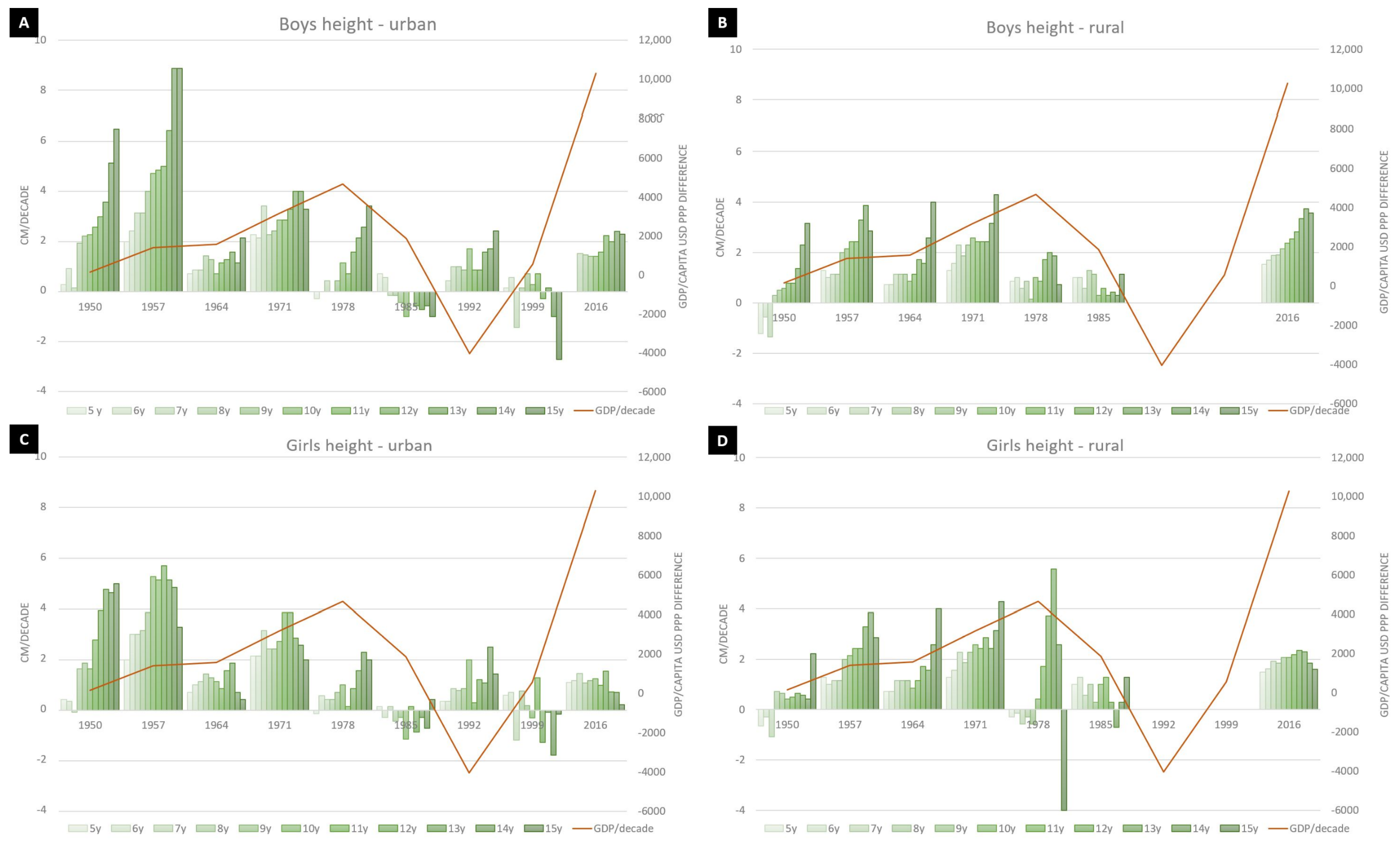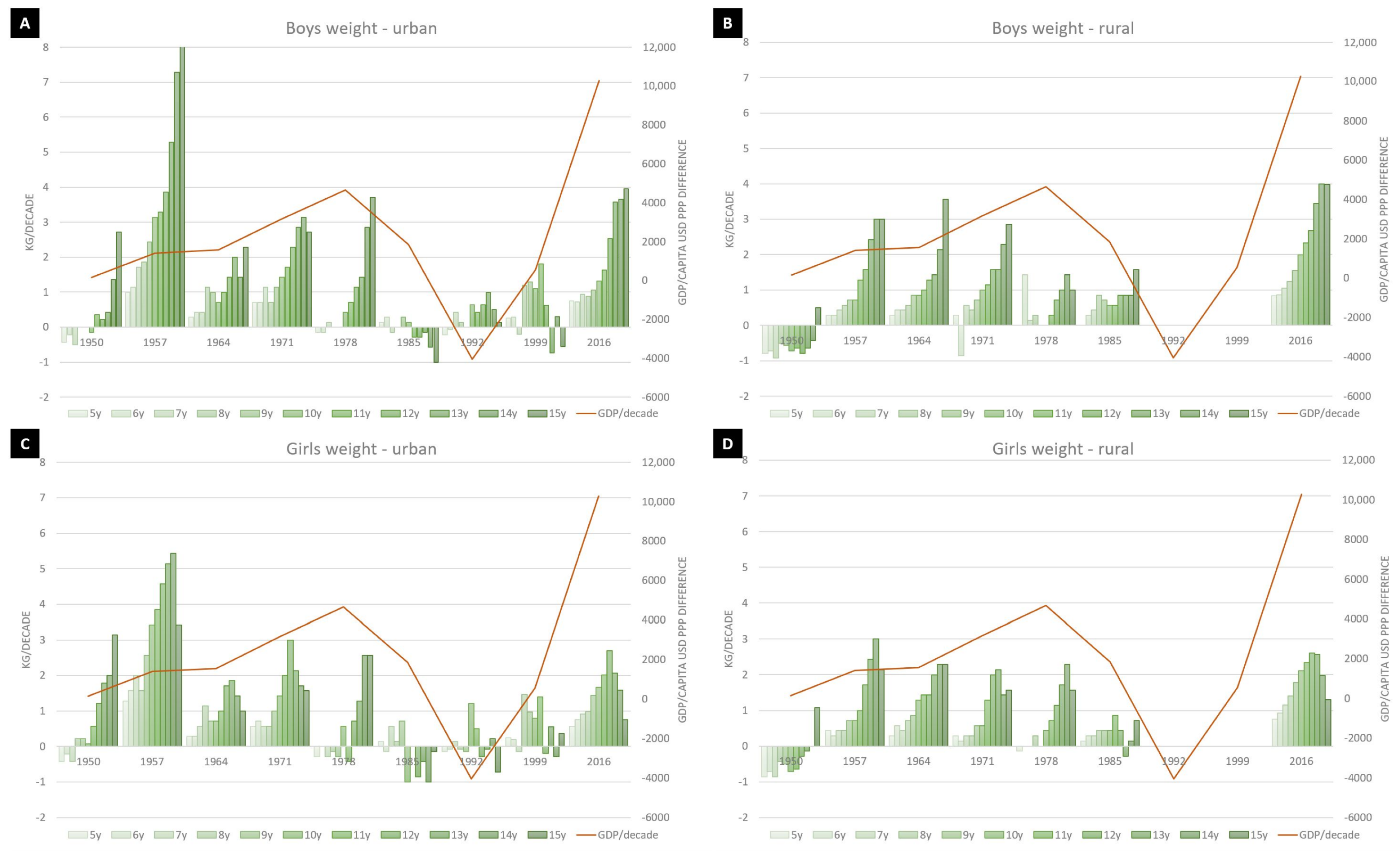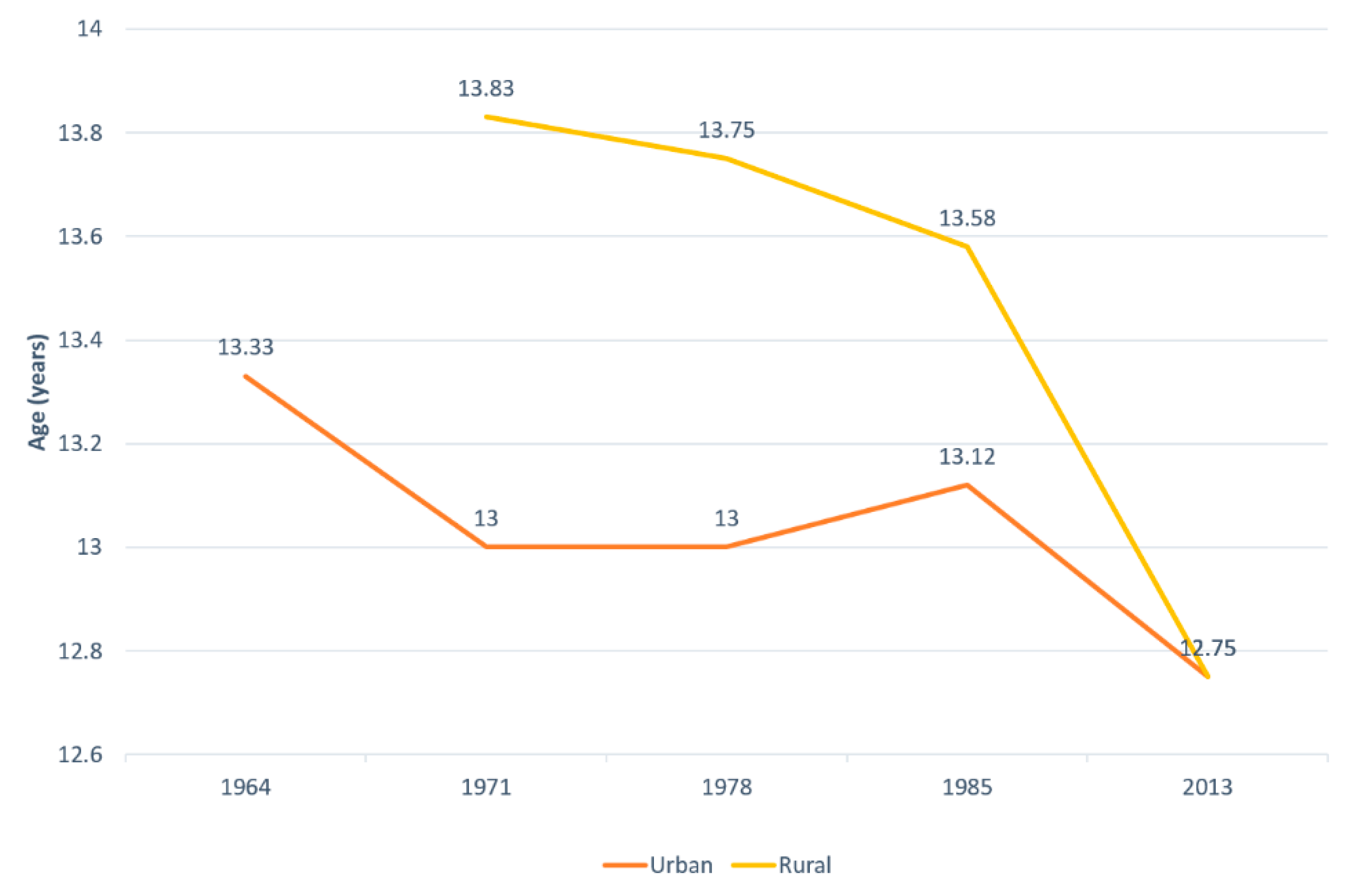Secular Trends in Height, Body Mass and Mean Menarche Age in Romanian Children and Adolescents, 1936–2016
Abstract
1. Introduction
2. Materials and Methods
Data Sets
- 1936—anthropometric evaluation of 11,761 boys and 10,723 girls 5–15 years of age covering the whole geographical area with measurements from both urban and rural regions [22] with available mean and standard deviation scores (SDS) for height and body mass.
- 1950–1999—National Institute for Public Health anthropometric evaluation—7 cross-sectional evaluations performed every 7 years comprising around 400,000 subjects for each survey, from birth to 18 years of age divided in rural and urban sets, covering the entire geographical area; mean values for height and body mass available; data was obtained for a fee from the Archive of the National Institute for Public Health—missing data due to archive damage and no electronic database available. Apart from the anthropometric evaluation, data on pubertal development was also collected. For the last cross-sectional study (1999) 300,405 subjects were evaluated, representing 4.2% of the entire 0–18 years of age population [23]. All measurements were performed by trained medical personnel using the same methodology.
- 2010—a sample of 1375 boys and 1476 girls, age 6–19 years, from 6 counties, not covering the whole geographical area with measurements performed by 3D scanning [24]
- 2012—regional growth references for school children—3731 subjects, aged 7–19 years from the western part of Romania [25].
- 2016—The synthetic growth references which included 8407 subjects age 3–18 years of age with measurements performed between 2011–2016, covering the whole geographical area, with combined measurements for urban and rural children. The methodology for developing synthetic growth references is described elsewhere [27]
- 2018—Data from the study on the biomotric potential of school children developed and carried out by the national Institute of Sport Research which included 275,501 school aged children 7–18 years old with full geographical coverage [28].
3. Results
3.1. Height Secular Trends
3.2. Body Mass Secular Trends
3.3. Mean Age at Menarche
4. Discussion
- The interwar years (1919–1939).
- The Second World War and first post-war years (1940–1947).
- The period of the communist regime (1948–1989) that can be further divided into three periods:
- The post-war and recovery years (up to the end of the 1950s).
- The economic boom (during 1960s and 1970s).
- The crisis period of the 1980s.
4.1. Limitations
4.2. Strengths
5. Conclusions
Author Contributions
Funding
Institutional Review Board Statement
Informed Consent Statement
Data Availability Statement
Conflicts of Interest
References
- Roche, A.F.; Towne, B. Secular Trends and Longterm Serial Growth Studies. In Perspectives in Human Growth, Development and Maturation; Springer Science and Business Media LLC: Berlin/Heidelberg, Germany, 2001; pp. 147–157. [Google Scholar]
- Gondek, D.; Bann, D.; Ning, K.; Grundy, E.; Ploubidis, G.B. Post-war (1946-2017) population health change in the United Kingdom: A systematic review. PLoS ONE 2019, 14, e0218991. [Google Scholar] [CrossRef]
- Cole, T.J. Secular trends in growth. In Proceedings of the Nutrition Society; Cambridge University Press (CUP): Cambridge, UK, 2000; Volume 59, pp. 317–324. [Google Scholar]
- Oyedeji, G.A.; Olamijulo, S.K.; Osinaike, A.I.; Esimai, V.C.; Odunusi, E.O.; Aladekomo, T.A. Secular trends in the growth of children aged 0–6 years in a rural Nigerian community. Ann. Trop. Paediatr. 1996, 16, 11–17. [Google Scholar] [CrossRef]
- Henneberg, M. Secular Trends in Body Height—Indicator of General Improvement In Living Conditions or of a Change in Specific Factors? In Perspectives in Human Growth, Development and Maturation; Springer Science and Business Media LLC: Berlin/Heidelberg, Germany, 2001; pp. 159–167. [Google Scholar]
- Garenne, M. Trends in age at menarche and adult height in selected African countries (1950–1980). Ann. Hum. Biol. 2020, 47, 25–31. [Google Scholar] [CrossRef]
- Fudvoye, J.; Parent, A.S. Secular trends in growth. Ann. Endocrinol. 2017, 78, 88–91. [Google Scholar] [CrossRef]
- Tanner, J. Growth as a Measure of the Nutritional and Hygienic Status of a Population. Horm. Res. 1992, 38, 106–115. [Google Scholar] [CrossRef]
- Meyer, H.E.; Selmer, R.; Meyer, R.S.H.E. Income, educational level and body height. Ann. Hum. Biol. 1999, 26, 219–227. [Google Scholar] [CrossRef]
- Kuh, D.L.; Power, C.; Rodgers, B. Secular Trends in Social Class and Sex Differences in Adult Height. Int. J. Epidemiol. 1991, 20, 1001–1009. [Google Scholar] [CrossRef]
- OECD. Purchasing Power Parities; Organization for Economic and Co-Operation Development: Paris, France, 2020. [Google Scholar]
- Harper, K.N.; Armelagos, G.J. The Changing Disease-Scape in the Third Epidemiological Transition. Int. J. Environ. Res. Public Heal. 2010, 7, 675–697. [Google Scholar] [CrossRef]
- WHO. The Double Burden of Malnutrition: Policy Brief; WHO: Geneva, Switzerland, 2016. [Google Scholar]
- Popkin, B.M.; Corvalan, C.; Grummer-Strawn, L.M. Dynamics of the double burden of malnutrition and the changing nutrition reality. Lancet 2020, 395, 65–74. [Google Scholar] [CrossRef]
- Łaska-Mierzejewska, T.; Olszewska, E. Anthropological assessment of changes in living conditions of the rural population in Poland in the period 1967–2001. Ann. Hum. Biol. 2007, 34, 362–376. [Google Scholar] [CrossRef]
- Marques-Vidal, P.; Madeleine, G.; Romain, S.; Gabriel, A.; Bovet, P. Secular trends in height and weight among children and adolescents of the Seychelles, 1956–2006. BMC Public Health 2008, 8, 166. [Google Scholar] [CrossRef]
- Malina, R.M.; Little, B.B.; Reyes, M.E.P. Secular trends are associated with the demographic and epidemiologic transitions in an indigenous community in Oaxaca, Southern Mexico. Am. J. Phys. Anthr. 2018, 165, 47–64. [Google Scholar] [CrossRef]
- Institutul Național de Statistică. INSSE—Baze de Date Statistice—TEMPO-Online Serii de Timp; Institutul Național de Statistică: Bucharest, Romania, 2019. [Google Scholar]
- Axenciuc, V.; Georgescu, G. Gross Domestic Product—National Income of Romania 1862—2010. Secular Statistical Series and Methodological Foundations; Romanian Academy Publishing House: Bucharest, Romania, 2017. [Google Scholar]
- The World Bank Group. GDP per Capita (Current US$); The World Bank: Washington, DC, USA, 2019. [Google Scholar]
- Pascanu, I.; Pop, R.-M.; Barbu, C.; Dumitrescu, C.; Gherlan, I.; Marginean, O.; Preda, C.; Procopiuc, C.; Vulpoi, C.; Hermanussen, M. Development of Synthetic Growth Charts for Romanian Population. Acta Endocrinol. 2016, 12, 309–318. [Google Scholar] [CrossRef]
- Râmneanţu, P. Korpergross e und Korpergewicht der Rumânischen Schulkinder. Gesundh. Erzieh. 1937, 3, 84–88. [Google Scholar]
- Cordeanu, A. Auxologie–Metode, Tehnici, Studii; Editura Universitara Bucharest: Bucharest, Romania, 2009. [Google Scholar]
- Niculescu, C.; Salistean, A.; Olaru, S. Anthropometric parametres of children in Romania, result of the anthropometric survey carried out in 2010–2011. Ind. Textila 2012, 63, 176–182. [Google Scholar]
- Chirita-Emandi, A. Growth References for School Aged Children in Western Romania. Acta Endocrinol. 2012, 8, 133–152. [Google Scholar] [CrossRef]
- Pascanu, I.; Hutu, S.; Cota, A.; Capraru, O.; Pop, R. Urban versus rural: Does the environment count in child development? Environ. Eng. Manag. J. 2016, 15, 707–713. [Google Scholar] [CrossRef]
- Hermanussen, M.; Stec, K.; Aßmann, C.; Meigen, C.; Van Buuren, S. Synthetic growth reference charts. Am. J. Hum. Biol. 2016, 28, 98–111. [Google Scholar] [CrossRef]
- Bitang, V. Assessment of the Biomotric Potential of Primary School Pupils. In Proceedings of the 8th International Conference Edu World 2018 “Education Facing Contemporary World Issues”, Pilesti, Romania, 9–10 November 2018. [Google Scholar] [CrossRef]
- Merrill, R. Introduction to Epidemiology, 7th ed.; Jones & Bartlett Learning: Burlington, MA, USA, 2017. [Google Scholar]
- Claessens, A.L.; Lefevre, J. Secular trends in somatic and motor characteristics of physical education students. Am. J. Hum. Biol. 1992, 4, 301–311. [Google Scholar] [CrossRef]
- Stănescu, M. Secular Trend of Students’ Somatic Development from Different Romanian Geographical Regions. In Proceedings of the ICPESK 2017—7th International Congress on Physical Education, Sport and Kinetotherapy, Bucharest, Romania, 15–17 June 2017. [Google Scholar]
- Stănescu, I. Quality of life in Romania 1918–2018: An overview. Calitatea Vietii 2018, 29, 107–144. [Google Scholar]
- Ianos, I. Romania. In Transition, Cohesion and Regional Policy in Central and Eastern Europe; Routledge: Abingdon, UK, 2019. [Google Scholar]
- Tanner, J.M. Growth as a Mirror of the Condition of Society: Secular Trends and Class Distinctions. Pediatr. Int. 1987, 29, 96–103. [Google Scholar] [CrossRef]
- Galton, F. Regression Towards Mediocrity in Hereditary Stature. J. Anthr. Inst. Great Br. Irel. 1886, 15, 246. [Google Scholar] [CrossRef]
- Danubio, M.E.; Sanna, E. Secular changes in human biological variables in Western countries: An updated review and synthesis. J. Anthr. Sci. Riv. Antropol. JASS 2008, 86, 91–112. [Google Scholar]
- Schmidt, I.; Jørgensen, M.; Michaelsen, K. Height of conscripts in Europe: Is postneonatal mortality a predictor? Ann. Hum. Biol. 1995, 22, 57–67. [Google Scholar] [CrossRef]
- Ioana, O.; Liliana, G.C.; Cozeta, M. Secular Trend of Growth in Height, Weight and Body Mass Index in Young Romanians Aged 18-24 Years. Procedia Soc. Behav. Sci. 2014, 117, 622–626. [Google Scholar] [CrossRef]
- Kagawa, M.; Tahara, Y.; Moji, K.; Nakao, R.; Aoyagi, K.; Hills, A. Secular changes in growth among Japanese children over 100 years (1900–2000). Asia Pac. J. Clin. Nutr. 2011, 20, 180. [Google Scholar]
- Dos Santos, F.K.; Maia, J.A.R.; Gomes, T.N.Q.F.; Daca, T.; Madeira, A.; Katzmarzyk, P.T.; Prista, A. Secular Trends in Growth and Nutritional Status of Mozambican School-Aged Children and Adolescents. PLoS ONE 2014, 9, e114068. [Google Scholar] [CrossRef]
- Topcu, S.; Orhon, F.Ş.; Ulukol, B.; Başkan, S. Secular trends in height, weight and body mass index of primary school children in Turkey between 1993 and 2016. J. Pediatr. Endocrinol. Metab. 2017, 30, 1177–1186. [Google Scholar] [CrossRef]
- Vignerová, J.; Brabec, M.; Blaha, P. Two centuries of growth among Czech children and youth. Econ. Hum. Biol. 2006, 4, 237–252. [Google Scholar] [CrossRef]
- Takaishi, M. Secular Changes in Growth of Japanese Children. J. Pediatr. Endocrinol. Metab. 1994, 7. [Google Scholar] [CrossRef]
- Mansukoski, L.; Johnson, W. How can two biological variables have opposing secular trends, yet be positively related? A demonstration using timing of puberty and adult height. Ann. Hum. Biol. 2020, 47, 549–554. [Google Scholar] [CrossRef] [PubMed]
- Hermanussen, M. Auxology: Studying Human Growth and Development; Schweizerbart Science Publishers: Stuttgart, Germany, 2013. [Google Scholar]
- Rodriguez-Martinez, A.; Zhou, B.; Sophiea, M.K.; Bentham, J.; Paciorek, C.J.; Iurilli, M.L.; Carrillo-Larco, R.M.; E Bennett, J.; Di Cesare, M.; Taddei, C.; et al. Height and body-mass index trajectories of school-aged children and adolescents from 1985 to 2019 in 200 countries and territories: A pooled analysis of 2181 population-based studies with 65 million participants. Lancet 2020, 396, 1511–1524. [Google Scholar] [CrossRef]
- Chirita-Emandi, A.; Barbu, C.G.; Cinteza, E.E.; Chesaru, B.I.; Gafencu, M.; Mocanu, V.; Pascanu, I.M.; Tatar, S.A.; Balgradean, M.; Dobre, M.; et al. Overweight and Underweight Prevalence Trends in Children from Romania—Pooled Analysis of Cross-Sectional Studies between 2006 and 2015. Obes. Facts 2016, 9, 206–220. [Google Scholar] [CrossRef] [PubMed]
- Bixby, H.; Bentham, J.; Zhou, B.; di Cesare, M.; Paciorek, C.J.; Bennett, J.E.; Taddei, C.; Stevens, G.A.; Rodriguez-Martinez, A.; Carrillo-Larco, R.M.; et al. Rising rural body-mass index is the main driver of the global obesity epidemic in adults. Nature 2019. [Google Scholar] [CrossRef]
- Toselli, S.; Ventrella, A.R.; Franzaroli, G.; Brasili, P. Growth and secular trend in school-children from Cento, Ferrara, Italy. Coll. Antropol. 2006, 30, 65–74. [Google Scholar] [PubMed]
- Fühner, T.; Kliegl, R.; Arntz, F.; Kriemler, S.; Granacher, U. An Update on Secular Trends in Physical Fitness of Children and Adolescents from 1972 to 2015: A Systematic Review. Sports Med. 2020, 1–18. [Google Scholar] [CrossRef]
- Parent, A.-S.; Teilmann, G.; Juul, A.; Skakkebaek, N.E.; Toppari, J.; Bourguignon, J.-P. The Timing of Normal Puberty and the Age Limits of Sexual Precocity: Variations around the World, Secular Trends, and Changes after Migration. Endocr. Rev. 2003, 24, 668–693. [Google Scholar] [CrossRef]
- Garduño, M.L.M.; Catillo-López, R.L.; Alcalá-Herrera, V.; Canal, D.D.D.C. The Decreasing Age at Menarche in Mexico. J. Pediatr. Adolesc. Gynecol. 2016, 29, 454–457. [Google Scholar] [CrossRef]
- Song, Y.; Ma, J.; Agardh, A.; Lau, P.W.; Hu, P.; Zhang, B. Secular trends in age at menarche among Chinese girls from 24 ethnic minorities, 1985 to 2010. Glob. Health Action 2015, 8, 26929. [Google Scholar] [CrossRef]
- Rao, S.; Joshi, S.; Kanade, A. Height velocity, body fat and menarcheal age of Indian girls. Indian Pediatr. 1998, 35, 619–630. [Google Scholar]
- Eckert-Lind, C.; Busch, A.S.; Petersen, J.H.; Biro, F.M.; Butler, G.; Bräuner, E.V.; Juul, A. Worldwide Secular Trends in Age at Pubertal Onset Assessed by Breast Development Among Girls. JAMA Pediatr. 2020, 174, e195881. [Google Scholar] [CrossRef]
- Vercauteren, M.; Susanne, C. The secular trend of height and menarche in Belgium: Are there any signs of a future stop? Eur. J. Nucl. Med. Mol. Imaging 1985, 144, 306–309. [Google Scholar] [CrossRef]
- Li, L.; Manor, O.; Power, C. Are inequalities in height narrowing? Comparing effects of social class on height in two generations. Arch. Dis. Child. 2004, 89, 1018–1023. [Google Scholar] [CrossRef]
- Eurostat. Mortality and Life Expectancy Statistics; Eurostat: Luxembourg, 2019. [Google Scholar]
- United Nations. World Population Prospects 2019: Highlights; United Nations Department for Economic and Social Affairs: New York, NY, USA, 2019. [Google Scholar]



Publisher’s Note: MDPI stays neutral with regard to jurisdictional claims in published maps and institutional affiliations. |
© 2021 by the authors. Licensee MDPI, Basel, Switzerland. This article is an open access article distributed under the terms and conditions of the Creative Commons Attribution (CC BY) license (http://creativecommons.org/licenses/by/4.0/).
Share and Cite
Pop, R.-M.; Tenenboum, A.; Pop, M. Secular Trends in Height, Body Mass and Mean Menarche Age in Romanian Children and Adolescents, 1936–2016. Int. J. Environ. Res. Public Health 2021, 18, 490. https://doi.org/10.3390/ijerph18020490
Pop R-M, Tenenboum A, Pop M. Secular Trends in Height, Body Mass and Mean Menarche Age in Romanian Children and Adolescents, 1936–2016. International Journal of Environmental Research and Public Health. 2021; 18(2):490. https://doi.org/10.3390/ijerph18020490
Chicago/Turabian StylePop, Raluca-Monica, Arava Tenenboum, and Marian Pop. 2021. "Secular Trends in Height, Body Mass and Mean Menarche Age in Romanian Children and Adolescents, 1936–2016" International Journal of Environmental Research and Public Health 18, no. 2: 490. https://doi.org/10.3390/ijerph18020490
APA StylePop, R.-M., Tenenboum, A., & Pop, M. (2021). Secular Trends in Height, Body Mass and Mean Menarche Age in Romanian Children and Adolescents, 1936–2016. International Journal of Environmental Research and Public Health, 18(2), 490. https://doi.org/10.3390/ijerph18020490





